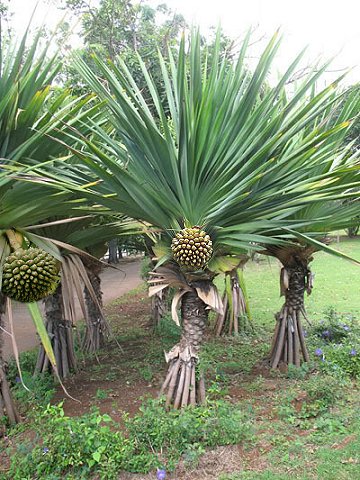
|
|
Screwpine (Pandanus utilisi)
|
Screwpine - Pandanus utilis
Within the family Pandanaceae, the genus Pandanus is thought to compose the largest group of
plants. It is estimated that there are somewhere between 500 to 1,000 species within this
genus. Pandanus utilis, is one such plant within this
family. The common screwpine (Pandanus utilis) is, despite its name, a monocot and not a
pine.
The origin of P. utilis has traditionally been thought to be Madagascar, but more recently the Mascarene Islands have been suggested as a possible place of
origin.It has been in cultivation for at least 200 years. A long history of cultivation and transport to many parts of the world makes the origin difficult to
trace. However, it is known to be grown in Senegal, Benin, Tanzania, Zimbabwe,
Mozambique, Madagascar, Reunion and Mauritius. P. utilis has been introduced to many tropical and subtropical
regions, including Central America, the Caribbean, the United States (southern
Florida, Puerto Rico), Brazil, India and Indonesia.
Pandanus utilis was discovered by French naturalist Jean Baptiste Bory de
Saint-Vincent. Although they were given a common name of pine, they are
monocots, more closely related to grasses, orchids and palms than to conifer trees such as
pines. Their name is derived from the spiral arrangement of their leaves around the
branches.
Pandanus utilis is a palm-like evergreen tree. Dioecious small- to medium-sized tree up to 20 m
tall, with a smooth, branched trunk and many pale brown basal aerial roots 2.5–7.5 cm in
diameter; branches with annular leaf scars. Leaves arranged spirally in 3
series, crowded towards the top of stems, simple, without petiole but with broad clasping
base, linear, up to 2 m long, but shorter on old trees, 3–11 cm
broad, tapering in a long point at apex, margins and ribs beneath
reddish-brown with many sharp, ascending, reddish, 1–4 mm long
spines, stiff, erect, with many parallel longitudinal veins.
Inflorescence unisexual; male inflorescence a branched spadix 30–80 cm long, in the axil of a pale
spathe; female inflorescence a subglobose head of densely crowded
ovaries. Flowers unisexual, without perianth; male flowers odorous, with 8–12 stamens inserted
pseudo-umbellately on slender columnal excrescences 10–15 mm long; female flowers with
3–8-celled ovary crowned by a sessile stigma.
Fruit a dome-shaped, compressed, angular drupe arranged in a pendulous, long-peduncled, subglobose syncarp 15–20 cm in
diameter, consisting of up to 200 drupes, each up to 3.5 cm X 4 cm X 2
cm, yellow when ripe, upper half free, base with a purple or red band; pyrene
3–8-celled, containing several seeds. Seeds endospermous, retained within the
endocarp.
P. utilis grows well near the sea, being salt-tolerant. It is a strictly tropical tree that will not survive
frost. It grows in full sun to partial shade but prefers at least 6 hours of direct
sunlight. Seeds take two to three months to germinate.
The screw pine has been shown to have many
uses. In coastal areas, it has been used for erosion control due to its numerous aerial
roots. These roots help bind the sand dunes along the coast from eroding water and
wind. In Reunion, Pandanus utilis trees are used as support for vanilla (Vanilla planifolia
Andrews). The trees serve as windbreaks mainly along the shore. Pandanus utilis is a
well-known ornamental in many tropical and subtropical regions. In temperate parts of the United States and Europe young Pandanus utilis are grown as indoor foliage
plants.
The leaves of P. utilis are used in different cultures for thatching and the production of numerous
materials. In areas like Madagascar, Reunion and Mauritius, the leaves are used to make
ropes, baskets, mats, hats, place mats, nets, thatched roofs for homes and even
paper. The waxy covering over the leaves makes them especially attractive for baskets and roofs with their natural
water-resistant surface. The leaves are also dried out and rolled, and used to make mats in
Kerala, India; and Hawaii. Care must be taken when handling the leaves because of their sharp
spines. In Mauritius and Reunion, sugar bags were made from the leaves. The aerial roots have been used for tying and in the production of
baskets, mats and hats, and their ends to make coarse brushes for
whitewashing.
The fruits form a starchy food, palatable after
cooking.From the fruit is extracted a flour to make cakes. Cooked male inflorescences are also eaten and are considered to have aphrodisiac
properties. The terminal bud or ‘c?ur de vacoa’ is consumed as a vegetable in
Reunion. Root decoctions are taken against venereal diseases. In Mauritius a root decoction is recorded to be taken in cases of fish poisoning and as an
aphrodisiac, and a decoction of the fresh leaves mixed with wood and charcoal of Hilsenbergia petiolaris
(Lam.) J.S.Miller (synonym: Ehretia petiolaris Lam.) is applied to the forehead for the treatment of
migraine.
Source:
https://en.wikipedia.org/wiki/Pandanus_utilis
http://uses.plantnet-project.org/en/Pandanus_utilis_(PROTA)
